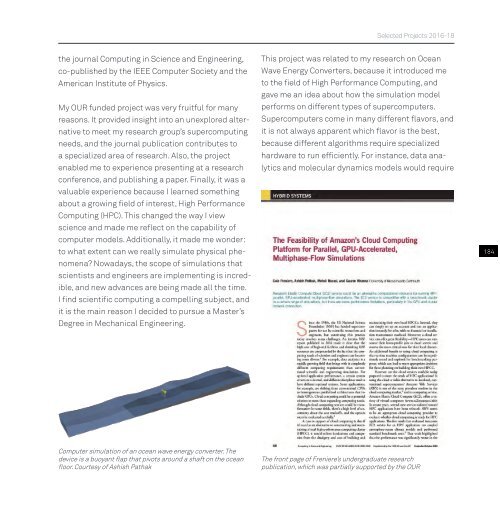Undergrad_Book_16-18_Pge_View_Print_no print marks_compressed
You also want an ePaper? Increase the reach of your titles
YUMPU automatically turns print PDFs into web optimized ePapers that Google loves.
Selected Projects 20<strong>16</strong>-<strong>18</strong><br />
the journal Computing in Science and Engineering,<br />
co-published by the IEEE Computer Society and the<br />
American Institute of Physics.<br />
My OUR funded project was very fruitful for many<br />
reasons. It provided insight into an unexplored alternative<br />
to meet my research group’s supercomputing<br />
needs, and the journal publication contributes to<br />
a specialized area of research. Also, the project<br />
enabled me to experience presenting at a research<br />
conference, and publishing a paper. Finally, it was a<br />
valuable experience because I learned something<br />
about a growing field of interest, High Performance<br />
Computing (HPC). This changed the way I view<br />
science and made me reflect on the capability of<br />
computer models. Additionally, it made me wonder:<br />
to what extent can we really simulate physical phe<strong>no</strong>mena?<br />
Nowadays, the scope of simulations that<br />
scientists and engineers are implementing is incredible,<br />
and new advances are being made all the time.<br />
I find scientific computing a compelling subject, and<br />
it is the main reason I decided to pursue a Master’s<br />
Degree in Mechanical Engineering.<br />
This project was related to my research on Ocean<br />
Wave Energy Converters, because it introduced me<br />
to the field of High Performance Computing, and<br />
gave me an idea about how the simulation model<br />
performs on different types of supercomputers.<br />
Supercomputers come in many different flavors, and<br />
it is <strong>no</strong>t always apparent which flavor is the best,<br />
because different algorithms require specialized<br />
hardware to run efficiently. For instance, data analytics<br />
and molecular dynamics models would require<br />
<strong>18</strong>4<br />
Computer simulation of an ocean wave energy converter. The<br />
device is a buoyant flap that pivots around a shaft on the ocean<br />
floor. Courtesy of Ashish Pathak<br />
The front page of Freniere’s undergraduate research<br />
publication, which was partially supported by the OUR



